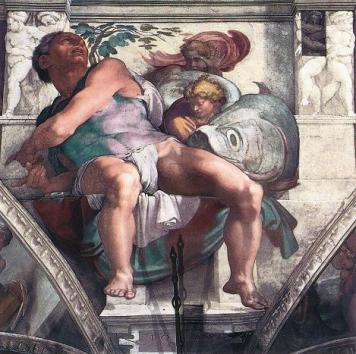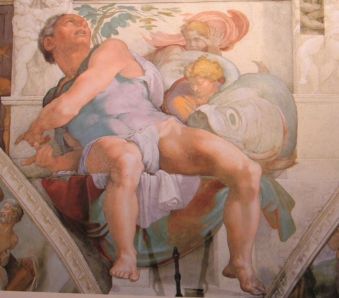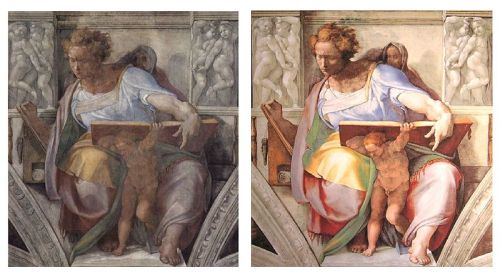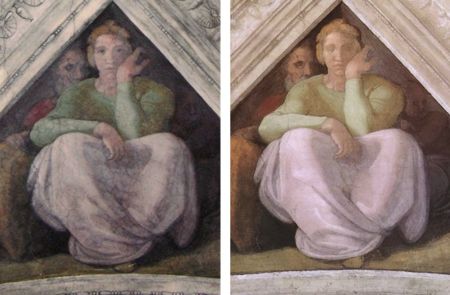Una duda cuando se restaura una obra. Cuando una restauracion se ha restaurado demasiado? Una interesante discusion que ha crecido con toda la cubierta mediatica que le han dado a un fresco de Ecce Homo en Zaragoza. Cae con una expresion que uso aqui a cada rato: el infierno esta lleno de gente de buenas intenciones.
El blog Philosophy of Science comienza el debate y en su presentacion me recordo las consabidas criticas a proyectos de gran envergadura como la restauracion de la Capilla Sixtina en Roma.
In the Fifties and Sixties, for example, many frescos were detached from the walls on which they had been painted on the grounds that it would protect them from damp and other environmental damage. In the Eighties, restorers came to the conclusion that this practice was in fact extremely damaging, and it is now never followed.
Aims of the conservators
The aims of the conservators were as follows:- To study the frescoes progressively, to analyse any discoveries and utilise the appropriate technical responses.
- To record every step of the operation in archival reports, photographs and film.
- To use only those procedures and materials which were simple, extensively tested, not harmful, and reversible.
- To repair cracks and structural damage that threatened the stability of the plaster.
- To remove layers of grime consisting of candle wax and soot that had been deposited by the burning of candles in the chapel for 500 years.
- To remove repainting by previous restorers that attempted to counteract the effects of soot and other accretions.
- To remove oil and animal fat used to counteract salination of areas where water had leaked through.
- To remove crystalline accretions of salt that had whitened areas where water had leaked through.
- To conserve surfaces that were in danger of further deterioration because of bubbling, and flaking.
- To restore sympathetically those areas where deterioration of one sort or another had obliterated details and caused loss of integrity to the whole, for example, filling a bad crack and painting the plaster in a colour matching the original.
- To maintain in small defined areas a physical historical record of the previous restorations that had taken place.
The Sistine Ceiling before restoration
There were big cracks in many places too, and water stains on the ceiling. A white crust of salt had formed here and there.Why didn’t somebody do something?
They had, at least half a dozen times. Already in Michelangelo’s time they painted over the salt crust, which was unremovable, with linseed oil to make it transparent.
A hundred years later a gilder rubbed all the frescoes with linen cloths and bread.
In 1713 somebody used wine to dissolve the grime. Another time someone else thought they could brighten up the colors with a coat of varnish.
But the frescoes kept getting darker and darker. The candle flames sent up wax and soot with each Mass and the open windows let in the black clouds of exhaust from the cars of Rome. The daily crowds of tourists brought great sudden changes of temperature and moisture too, which added to the general deterioration.
In 1981 the Vatican decided to save the frescoes. They announced a long-term restoration project. First the ceiling and then the front wall: Michelangelo’s Last Judgment fresco.
How were the latest bunch of experts going to proceed? Which method were they going to use this time? Bread? Linseed oil? Varnish? Some dissolvent? How DO you clean a dirty picture? What if when you clean it the colors come away with the soot?
To some they seemed just a little too bright. “Could an artist of such supreme taste have been content with those garish colors? they asked.
“And don’t the figures look flat now? If there’s one thing Michelangelo put into his paintings it was relief.”

 The great Jonah before and after the cleaning.
The great Jonah before and after the cleaning.They noticed that certain features, certain details of the old darkened version which they had admired, had disappeared. Some of Michelangelo’s shadows were gone and some of the “new” ones looked odd. For example, they were red. Who ever heard of a red shadow?

Daniel before and after the cleaning
It looked like maybe the restorers had removed some darkness that WAS NOT grime but a wash of charcoal Michelangelo himself had applied to give the figure relief. The proof came from the missing black eyes of two or three of the figures. Michelangelo had evidently painted the eyes ON TOP OF the plaster. Now they were gone and the figures looked blind!

A young woman in the Jesse spandrel before and after
Oops! Demasiado blanqueador. Please denle UNDO. Que no hay UNDO, pues asi se quedo...
Most people are happy to see the frescoes so brand-new looking. The cleaning job has to be given very high points. It was done conscientiously and by experts. Was it wrong to trust them? The worst is that there is no going back. What they did cannot be undone, which violates a simple norm of modern art restoration.
Maybe if Michelangelo turned over in his grave when he heard about it, now, after reflection, he would admit that, all in all, the ceiling is closer to the way he left it. The world still honors him like no other artist.
Les dejo este excelente tratado de la restauracion de obras arrancadas de las paredes y montadas en nuevas cupulas. Da una idea de la magnitud de la obra que implica restaurar un fresco.
As a general conclusion it can be underlined that the reconstruction,
restoration and conservation of icons and frescoes cannot follow any algorithmic
steps. It requires creativity, and a professionally qualified degree of
improvisation is to be expected. Also in some cases team work is essential. The
modern technologies, some of them very high, can only help and enhance the
work of specialists; they cannot replace them in any way.
Bueno aqui un tour virtual:
http://www.vatican.va/various/cappelle/sistina_vr/index.html
Sigue impresionando igual, con o sin relieve. Seguiremos informando segun me libre de mis tareas diarias...



No comments:
Post a Comment